When you think of a tropical landscape, the first plants that most likely come to mind are palm trees, plumeria, beautiful flowering shrubs like crotons, plus wide-leafed foliage like heliconias. There is another plant that is equally abundant in tropical landscapes that can be glossed over. However, it is one of the most important types of plants when pulling a tropical landscape together. These plants are the bromeliads.
When I first started incorporating a tropical look into parts of my garden I didn’t plant bromeliads. At the time I believed they would require too much water and that the maintenance would catch up to me. As the years went on I realized that long-lasting perennials are a much preferred option over the yearly replacement of annuals in the garden. Finding low-growing, colorful perennials can be challenging. Hence my first bromeliad plantings. I wish I had started buying and planting them sooner. Like almost every plant group, there are representatives for all kind of planting needs. There are bromeliads that can handle all the water you can give them and even ones that are xerophytic. There are bromeliads that love the sun and ones that grow better in full shade. Some can be planted in poor soils and still others are entirely epiphytic. The point is: the thinking that bromeliads are tropical, water-loving, colorful plants with spiny edges isn’t entirely true.
Southern California can be challenging for bromeliads when you make the wrong selections for your microclimate, irrigation availability or sun exposure. One bromeliad that really doesn’t care about any of that is Aechmea blanchetiana. It is quite possibly the most bulletproof bromeliad for Southern California. Aechmea blanchetiana is one of the larger bromeliad species and even though it is endemic to Brazil’s Atlantic forest, I can vouch for its cold-hardiness. Mine suffered no damage when it saw 28° F during the winter of 2007. Online you can read reports of Aechmea blanchetiana taking frosts and lows of 26° F with very little damage. It has proven for me to be a great way to get a hardy, colorful, long-term perennial into the garden.
The vibrant yellow or orange colors stand out in a landscape. A great example showing how much color Aechmea blanchetiana can add to a landscape is a planting at a friend’s house – I did a tour of his garden a few months back. It makes a bold statement when planted like shown below.
While Aechmea blanchetiana can grow in shade, you will lose the rich colors, as the yellow coloration will turn to green. I find this bromeliad to be a true sun lover along coastal Southern California. Inland you will want a little protection from the hot sun. If you want to add some contrasting color to your garden, grow Aechmea blanchetiana in mostly sun and you will be rewarded.
One great characteristic that most bromeliads have is that they include a free replenishing supply of additional plants. Aechmea blanchetiana, when happy, will pup profusely and provide you with more plants than you will ever need over the years. In fact, every plant that is in my garden started from a single pup almost 10 years ago. I get so many pups now that I can’t give them away fast enough and many end up in the trash.
As I mentioned earlier, Aechmea blanchetiana has a great varying degree of water tolerances. This plant is just as happy in a tropical landscape as it is in a xeriscape. Yes, you can plant them in a xeriscape with minimal supplemental watering. You just want make sure they get some drip irrigation every week or two. The watering this plant below gets amounts to just an accidental misting from an MP Rotator sprinkler head. Only towards the end of summer when it gets hot does it begin to shrivel up to some degree. So I hand water it once or twice during heat waves and it does fine on its own the rest of the year. I also think this bromeliad looks great complimented with rocks, which xeriscapes should have anyway.
Many of the colorful leafed bromeliads have simple, or even just plain ugly, flowers. While Aechmea blanchetiana flowers won’t win a beauty contest, they’re certainly attractive enough to demand attention. The showy part of the Aechmea blanchetiana flower stalk is actually made up of clusters of red and yellow bracts. These flower stalks can reach as high as 5 feet tall and eventually open small nondescript flowers. This flower spike can last as long as a few months. Like all bromeliads, once that particular plant flowers, it will die soon after. The good news is that it will take a few years before each plant flowers, and as I mentioned above, it will produce plenty of replacement pups before it does die.
If I were to have a complaint about Aechmea blanchetiana, it is that due to its large size it will store a lot of water in the cups when they get regular sprinkler irrigation. In my yard this makes for the perfect breeding ground for mosquitos. It is easy to kill the larvae, but with the amount of plants I have now, it is too time consuming to run a regular maintenance routine. And frankly I haven’t really noticed any more mosquitos in my yard than in anyone else’s. Still, every few months I will put a drop or two of Malathion in each cup and that kills current mosquito larvae and prevents others from hatching. This works until the concentration of the Malathion becomes too diluted due to the regular irrigation.
Before I close out this post I wanted to show a red-leaf variety of Aechmea blanchetiana. This one is called Aechmea ‘Pinot Noir.’ It use to be difficult to find but has become more available the last couple of years. While I don’t find the color as vibrant as the common yellow, it is nice to be able to mix up the colors.
So who else grows Aechmea blanchetiana? What are your experiences with it? Please share in the comments section below this post.

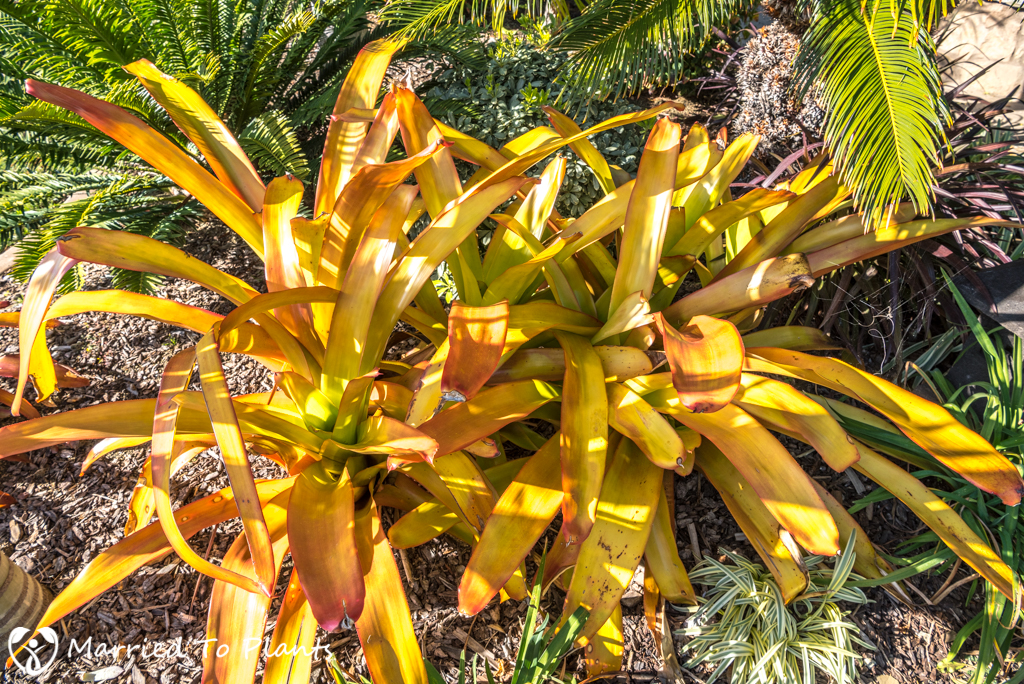
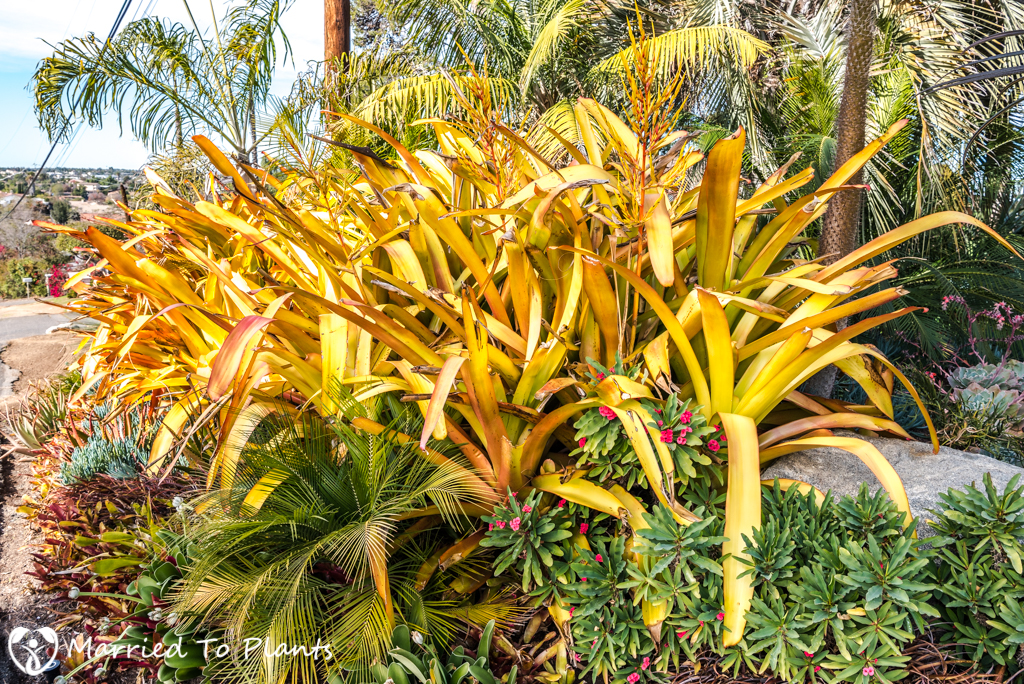

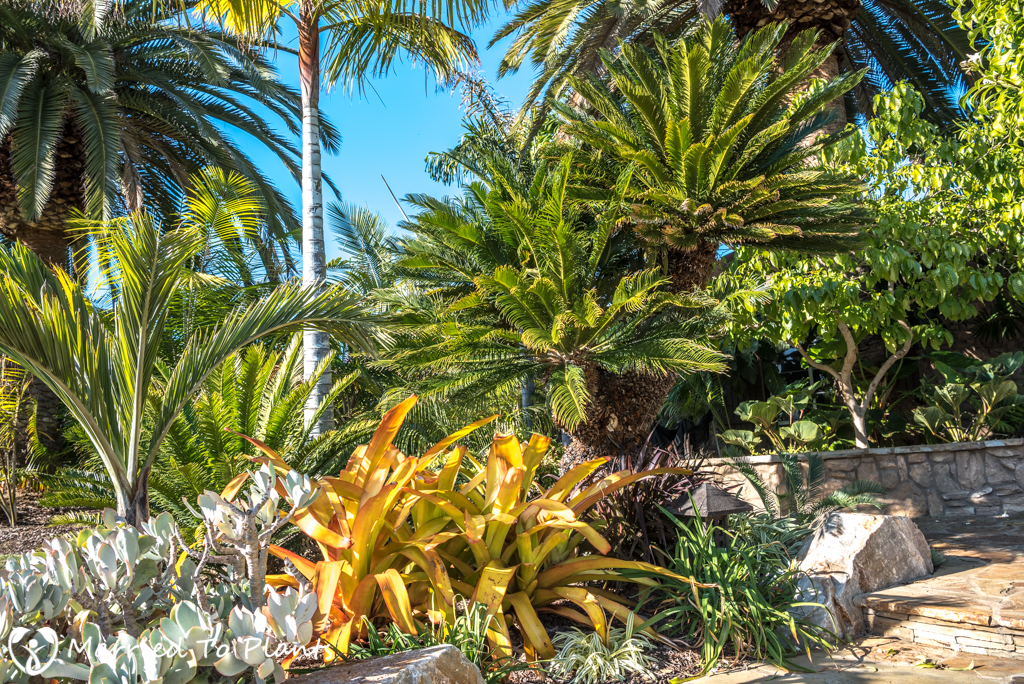
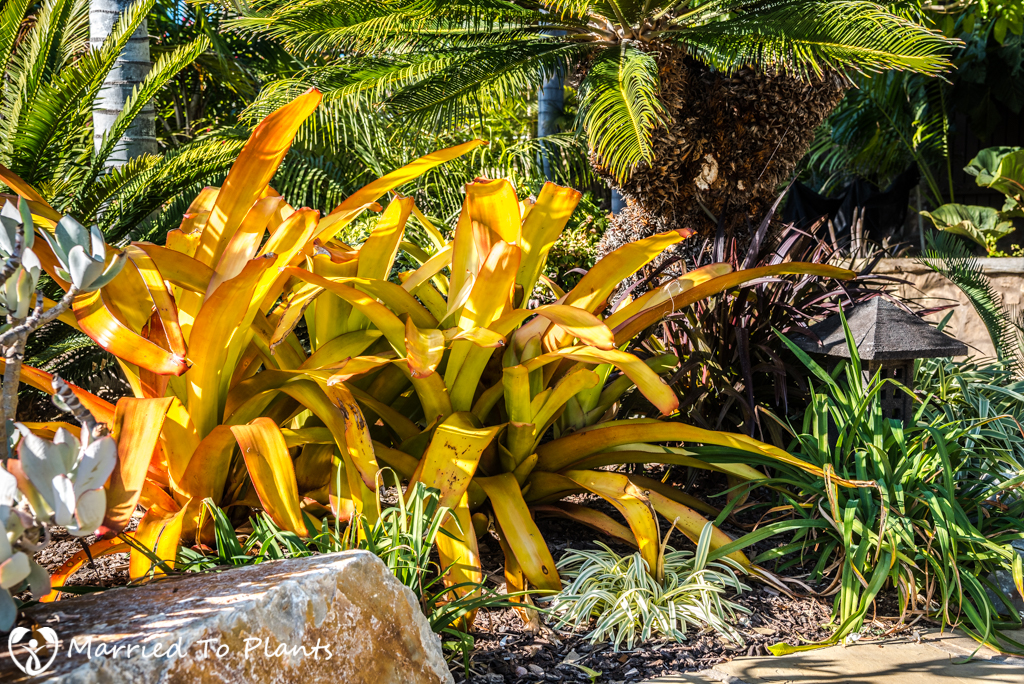
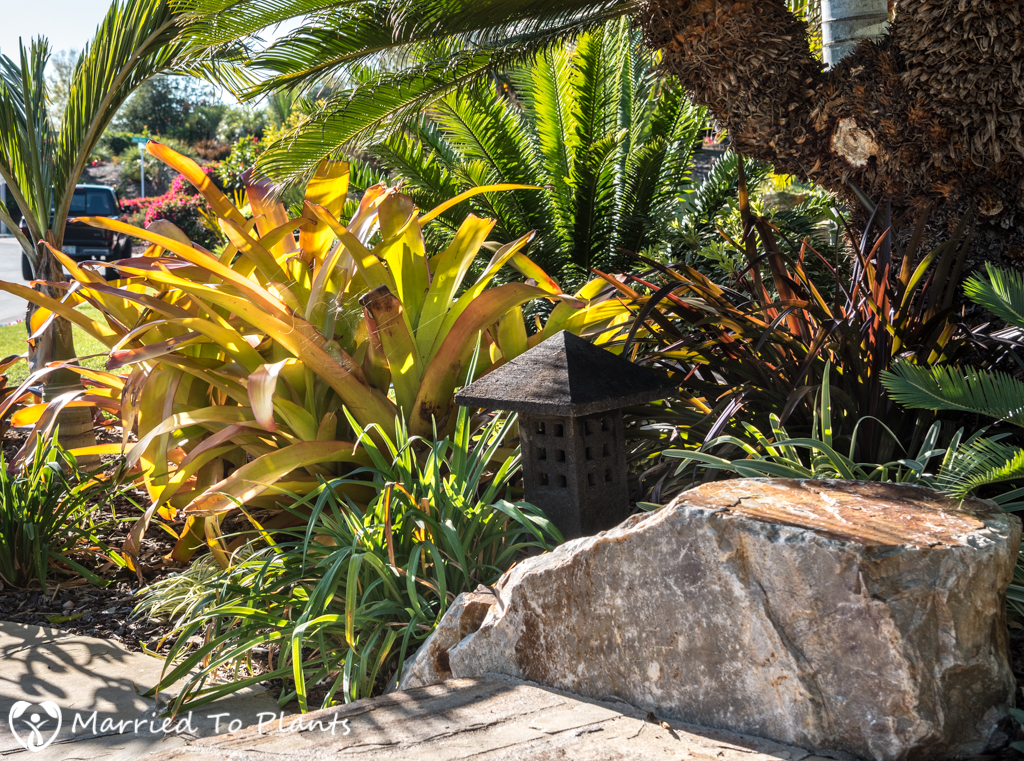
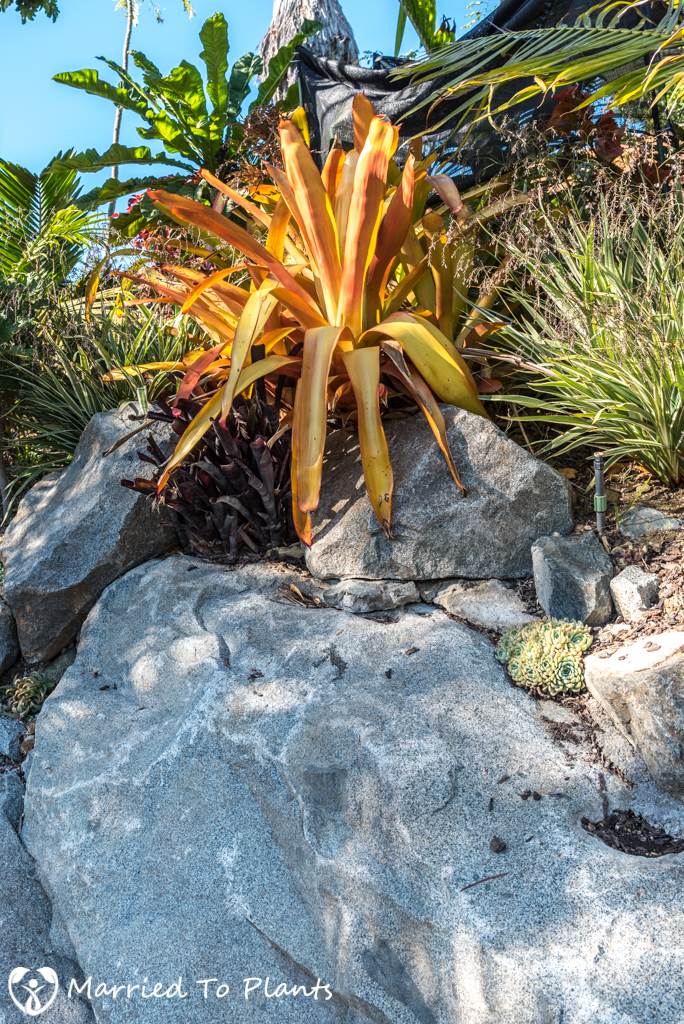
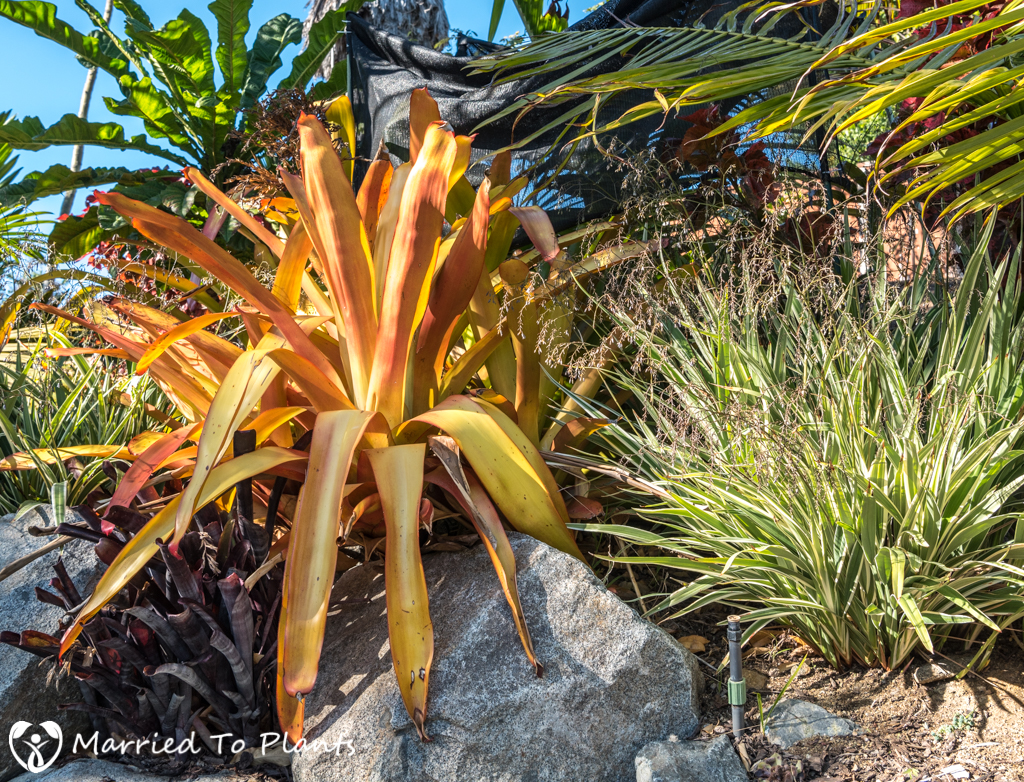


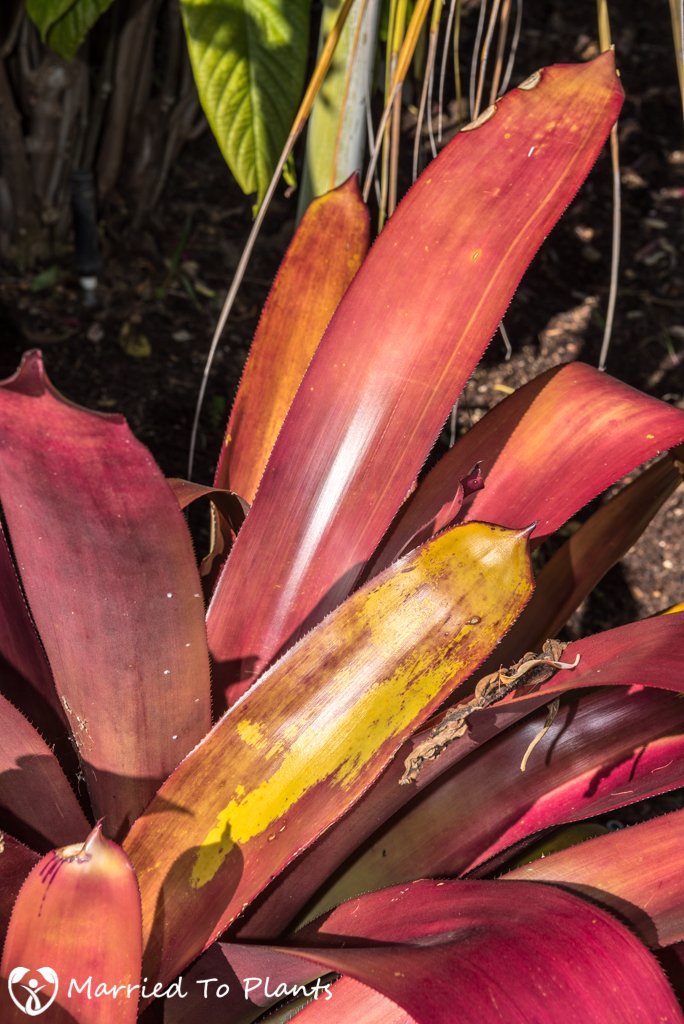
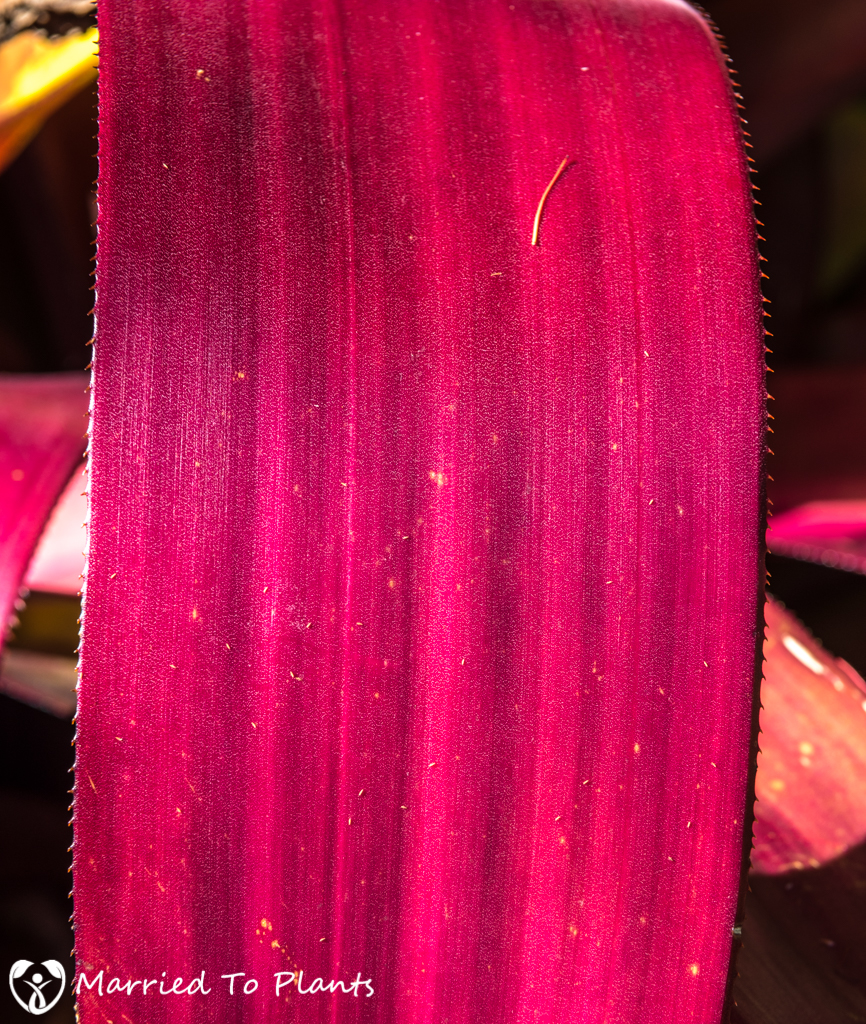
Its been on my list to order for spring a couple of years now. This year for sure with all the rains we have had.
Len I thought you might like this link of growing in tree’s what only can be done in California..Aeoniums in tree’s with Bromeliads, Orchids and ferns. He has other short vids of this great combo.
https://www.youtube.com/watch?v=nBwKtVMoEJc
If you are ever in SoCal you can have some pups off mine for free.
Thanks for sharing the video. Really cool.
Hello Len,
Does your kind offer still stand? I’m in love with red, orange and yellow aechmea blanchetiana and would be VERY grateful for some pups for my “gifted garden” here in San Diego. Also, we have a sharing shelf where we put various succulents we cultivate which I’d be glad to bring you if you’re in need of anything (we have a wide variety).
Thank you either way — Mimi
I might have some. Have to look. Reach out to me on contact page. Thanks.
Hi there,
I see this post is several years old but thought it couldn’t hurt to ask if you still have pups up for grabs. I am in West Hollywood, CA.
Thank you so much for your beautiful, thorough and informative post!!!
I have admired bright yellow orangey Bromeliads like these on Maui. Do you know where they might be available in for purchase in San Diego for my tropical garden?
Hi Jon, Phil at Jungle Music in Encinitas should have some soon as I am selling him some of my pups.
Hi, Join the San Diego Bromeliad Society and you will find great plants like these. Lots of bromeliads on the raffle table at each monthly meeting and also auctions.
We meet 2nd Sat. of each month in Room 104 Casa del Prado in Balboa Park every month except August. Have our annual show and sale 2nd Sat. in June. SPECIAL:
May 20-June 3, 2018 we will host the Bromeliad Society International at Paradise Point Hotel (used to be Vacation Village). Sales people from all over the U.S. and all sales open to the public on Sat. June 2 and Sun. June 3. Check out info at SanDiegoBromeliadSociety.org. P.S. I have Blanchetiana in full sun and they grow prolifically and also have a PintoNoir.
Thanks Nancy. Look forward to the 2018 convention.
Any idea where I can find about 2 dozen Aechmea Blanchetiana in the Ventura area? Or even LA or Orange County for that matter. I have been looking for about a year to no avail. I have found them online but between the price and shipping they are way too expensive, especially considering that they pup frequently. Thanks for your help.
I don’t. If you are ever in the San Diego area, I’ll sell you cuttings from mine. Most mine go to Jungle Music.
I know of a place in Carpinteria that is worth checking out?
Call and go to live art plants in Gardena
You can also use BT to kill mosquito larvae. It is much less toxic.
I’ve got a beauty In my yard in Anguilla. It is giving me pups like crazy. How do I go about separating them from the mother plant? And can I simply repot the pups or plant elsewhere? I need a little help, as I am a first time owner of this baby.
Brigid, don’t worry, you can’t mess up as these are so easy. I simply cut the pup off as close to the mom as I can get and then stick the pup right into the ground. It roots in a few weeks. It really is that easy.
You have orange bromelia
What soil mix did you use to get yours started. I was just gifted 25 year olds that have a few pups we just dismantled, dug a hole not clueless on what medium to use. I have black bark. Some potting mixes and cactus mix and peat moss. Do I just mix it all up and dump? I got tomatoe plant wire to hold up these monsters because not much root ball.
Honestly, I’ve used all kinds of mediums that were available at the time. From pumice to orchid bark to even just a cactus mix. These things root super easy.
Wonderful article, and I actually have one of your plants through Jungle Music!
I’d love to know: do you feed yours at all? (and if so, with what?)
Does anyone know if there is a Bromeliad club in Los Angeles, and/or a great store for buying interesting varieties of bromeliads?
Hello from Florida!
Blanchetianas grow very well here too. I am wondering if you can tell me the name of another plant in your photos? I like the contrast of its darker, burgundy grass-like leaves with the Blanchetianas. I see it most clearly in your 6th photo, planted to the right-side of the Blanchetianas. Our climate is different than your area, but I am always on the lookout for different plants that are underutilized in landscape designs.
Thank you for your informative website and inspiration to many home gardeners and professional designers.
Krista
Crinum ‘Menehune’